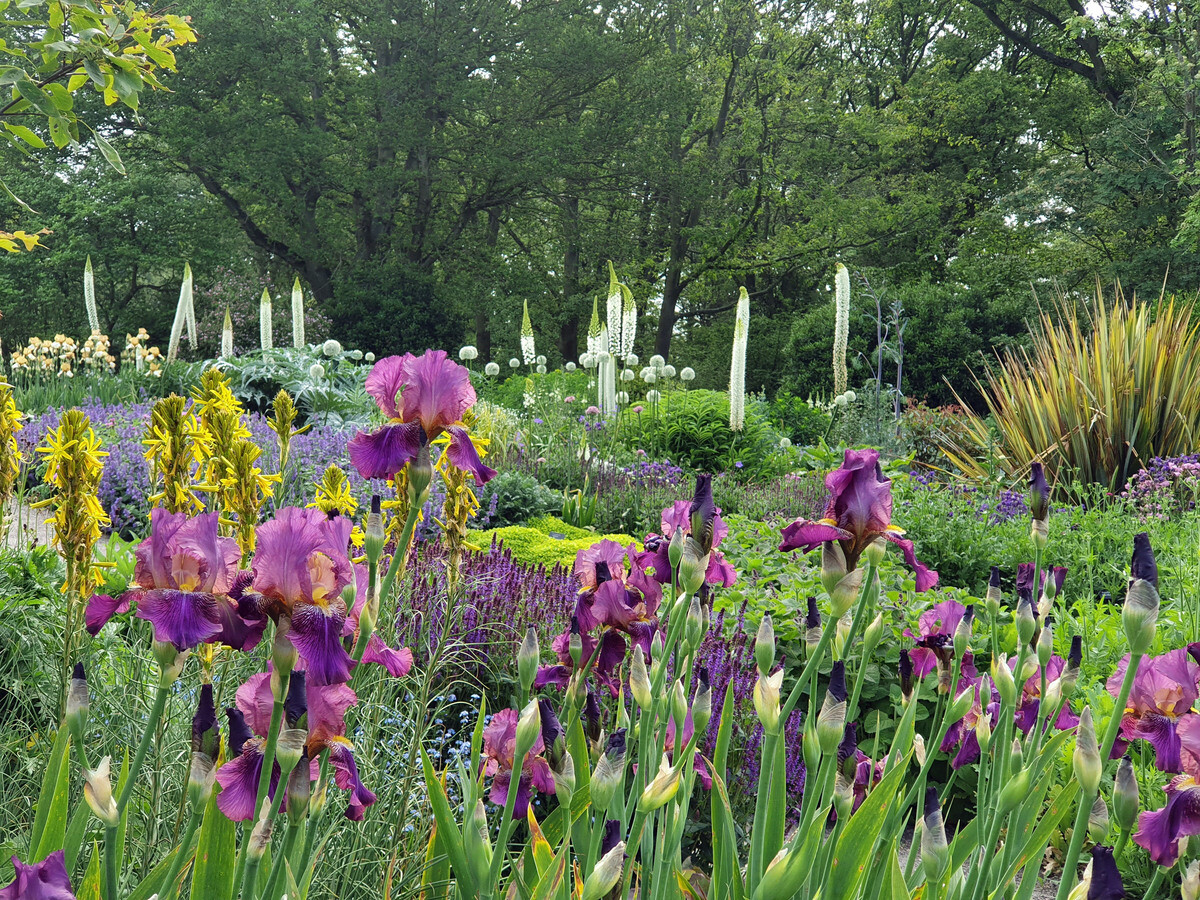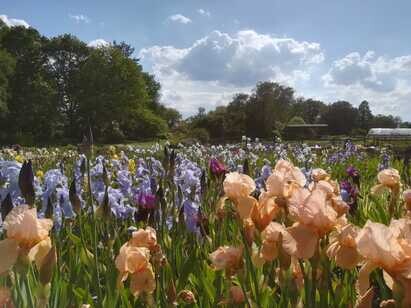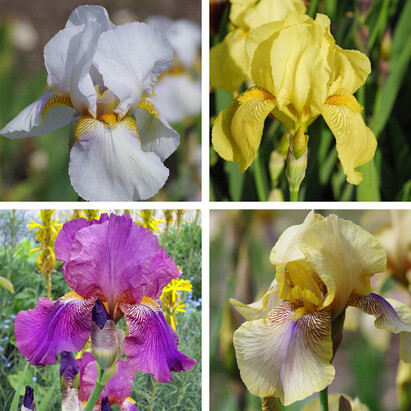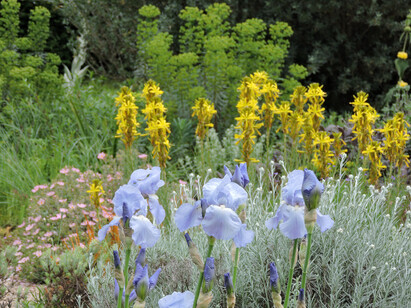Find out what the propagation and garden teams have been up to this week.

How to grow and care for bearded irises

Whether you love them or loath them, it cannot be denied that the tall bearded iris is a statement plant, a structural plant, a plant that creates an opinion and a plant which drives the need, in some of us to collect. I had never considered myself an iris collector until now but upon writing this blog I have discovered that I have clearly become one.
I remember the day the irises’ siren call first pulled me from my work and mesmerised me from across a stock bed. It was a mid-May morning and I had been hand weeding in the bottom corner of the top stock beds, lost behind a green wall of fresh new growth of stock plants including Rudbeckia fulgida var. deamii, Solidago rugosa ‘Fireworks’ and Solidago ‘Foxbrook Gold’ totally engrossed in my work and the task at hand.
Realizing I was due an overdue tea break, I stood from my labours, stretched, and started to walk the uphill incline of the stock beds, towards the staff car park and the thermos flask of coffee that awaited me. However within my first twenty steps, a warm summer breeze blew up soft and low and carried upon it an abundance of heavenly scents, in that moment all thoughts of the overdue tea break were lost.
The perfume that had so distracted me was clean and crisp with a citrus undertone and yet at the same time it also had a musky, heavy scent with the heady richness of a dark chocolate aroma, while bizarrely also being floral and light, with a hint to it of times gone by. As I followed my nose I found myself being drawn ever onwards towards the new tall bearded iris stock bed.
These stock beds had been created the previous year and it was the first time in many years that all our tall bearded irises had been brought together in one place. These stock beds were created at the time of propagation, which is during July and August, about a month after they have finished flowering and the seed heads are ripening. The iris stock beds had been laid out in rows, with five or six cultivars per row, planted on mass in 4 ft by 8 ft blocks, one block per cultivar, for ease of access, maintenance and cataloguing. With over twenty different cultivars in the collection at the time, the effect was breath taking, a riot of colour, like an explosion in an artist’s paint box. In a way this turned out to be a very apt description as the majority of irises within the collection at that time were examples of the artist and plantsman Cedric Morris’ work. The combination of ‘Benton Apollo’ (yellow), ‘Benton Menace’ (purple), ‘Benton Pearl’ (white with a hint of blue) and 'Benton Olive' (creamy yellow with a splash of lilac) clearly standing out in my recollection of this day as their contrasting yet complimentary colours and simple plain blooms, being less frilly and flamboyant then many other types of bearded irises, made a striking display. From that moment I was hooked, now our collection is in excess of 50 different cultivars and still increasing.

For many, a bearded iris is a floral firework of a bloom almost over before it has begun, hardly worth the effort and with the average iris only flowering for a month, I can understand this point of view. However, for me, the anticipation of a striking display that you have waited eleven months for; the build up to the blooms as the flower stems start to gain height, reaching for the sky and then their final eruption into flower is like the finale of spring and the opening of the summer season is always worth the wait.
How to grow and care for bearded irises
Lift and divide bearded irises a month after they have finished flowering, around July and August. Plant out between July and mid- October to allow them to get well established before the winter sets in. These irises need plenty of heat and sun and the soil must have very good drainage. If they can be planted on a slope or in a raised bed then even better. Ideally they will be well spaced at approximately 30 to 40 cm apart, much closer and they will need to be thinned out more often to maintain flowering and to reduce diseases.
The rhizomes like to be exposed, sitting on the surface of the soil with the roots securely in the soil. Remember that an iris grows enlarging towards the fan like leaves of the plant, so if planting near a wall or structure you must give them room to grow. Water in the irises once planted but once established they need very little water and it is better to under water than over water a bearded iris as too much water can lead to rot.

They can be divided every 3, 4 or 5 years before they become overcrowded and begin to flower less. The clumps of irises that need dividing can be easily identified by viewing the plant from above, if the foliage appears to make a complete circle and therefore the rhizomes are being shaded by the leaves then it is time to lift and divide that clump. Iris do not really need feeding but depending on your soil type you may consider an early spring feed formulated to promote flower growth. If you do feed, then avoid a using a fertilizer with a high nitrogen level as this just produces lots of foliage growth and reduces the number of blooms produced.
Bearded irises are relatively trouble free if you plant them correctly and ensure they get enough light and space, however you may encounter two common problems. Leaf spot, which is a fungal problem that occurs in wet conditions. These yellow and brown spots appear near the tops of the leaves spreading downwards. Cut off and destroy the affected leaves, take note of the spacing between the clumps of irises as it is often an indicator of overcrowding and lack of airflow around the plant therefore the plant would benefit from being lifted and reset with wider spacing. The second problem is root rot; this appears at the base of the leaves and shows as a yellowing of the leaf fans. Often cause by the soil having poor drainage or that the iris is poorly rooted and unstable in the ground. Simply lift the affected plant, cut away the soft tissue with a knife and disinfect the wound made to the rhizome with sulphur or a 10% bleach solution and replant, destroying the infected material that has been removed.
For our list of bearded irises, click HERE.

Written by Growing Manager Marc

COMMENTS